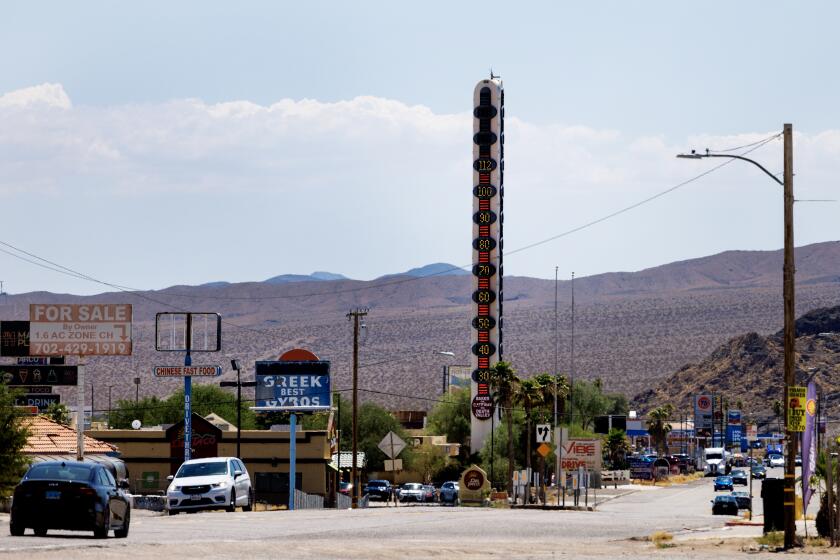Rich Heritage Comes to Life : Point Vicente: Interpretive Center docents explore the South Bay’s past and present and share it with others. : IN OUR BACK YARD: An occasional look at South Bay people, places and lifestyles
When Sue Kersey went looking for a dance class for her daughter, she did not know she was about to discover a place that would soon become a big part of her life.
“I saw this sign that said ‘Point Vicente Interpretive Center’ and I thought: ‘This looks like a theatrical building. I’ll ask there,’ ” she said, laughing at what she now knows is a common mistake for first-time visitors. “I didn’t find any dance classes, but I certainly found something for me.”
What she found was “a little patch of paradise,” a museum cum outdoor classroom offering displays and descriptions on everything from geology and American Indian history to marine biology and early South Bay lore.
Operating largely because of the efforts of volunteer docents such as Kersey, who said she became so fascinated with the place that she donates more than 800 hours of service each year, the center has become a unique South Bay landmark.
A squat structure built of native Palos Verdes stone, the 9-year-old center sitting on the 125-foot cliffs of Point Vicente has been the fulfillment of a dream and the beginning of a grander one for Rancho Palos Verdes.
It all started, oddly enough, with a shooting range.
Once part of Ft. MacArthur, Point Vicente was the site of a huge earthen berm soldiers used for target practice. Even after the federal government vacated the land, the Los Angeles County Sheriff’s Department sometimes used the berm as a training range for new deputies.
Then development began to crowd in around the range, Rancho Palos Verdes became an incorporated city in 1973, and the city’s founders began looking for park space and a means to preserve some of the last ruggedly beautiful coastline in Southern California.
Bullet-battered Point Vicente seemed a natural.
With its rugged cliffs, panoramic ocean views and gently rolling terrain, it offered the kind of wild beauty and solitude that had drawn many residents to the peninsula in the first place.
“Way back in the early gleam-in-the-eye days, it was envisioned simply as having a lot of walking trails and interpretive signs, like what you would find in a national park,” city Parks and Recreation Director Mary Thomas said.
But the city also wanted a place to create a sense of community, Thomas said. An interpretive center to teach residents about the geology, history and natural resources of their home seemed a logical start.
After nearly a decade of planning, grant writing and fund raising, the $1.5-million center became a reality. Nineteen acres of the 28-acre site have been landscaped and opened to visitors, including numerous school groups from throughout Los Angeles.
Inside, the center is essentially one large room, carefully divided and packed with displays covering millions of years of natural and cultural history. A small, second-floor viewing area provides binoculars and 360-degree views.
Volunteer docents guide visitors from station to station, expanding on the printed signs and gearing each tour to the time and interests of the audience.
During one recent tour, docent Bill Ritchie entertained 2-year-old Mark O’Berry and his 4-year-old brother, Paul, of Redondo Beach with pictures, models and descriptions of seaweed and whales.
“This seaweed is called kelp and it grows really fast, as much as the height of your brother, in a single day,” Ritchie, 72, told a wide-eyed Paul. “You’ve probably eaten kelp too. It’s harvested right out of the ocean and used in all kinds of things, like ice cream.”
Later, Ritchie tried to help the boys understand how big a 100-foot blue whale is.
“If you took three school buses and put them end to end, that would almost be the size of a blue whale. Almost,” he said.
The boys’ mother, Jacqueline O’Berry, said Ritchie was getting through to her sons.
“Paul won’t say anything at all while he’s here, but on the way home he’ll be repeating everything to me and then to all his friends,” she said.
Ritchie said he particularly likes telling visitors about the Palos Verdes Peninsula’s early history.
An island when the greater Los Angeles basin remained under the Pacific Ocean, the peninsula joined the mainland roughly 50,000 years ago.
American Indians began living in Palos Verdes as much as 30,000 years ago, Ritchie said. Artifacts from Malaga Cove and Abalone Cove were collected in the 1920s and 1930s by an early South Bay resident, Tom Tower, whose relatives recently donated them to the center.
Descendants of the Chumash from the Santa Barbara area and the Shoshones of the deserts east of the Sierra Nevada, the tribes of the Palos Verdes Peninsula were peaceful traders who traveled extensively throughout the area by foot and canoe.
Spanish explorers named them Gabrielinos, but the local tribes are believed to have referred to themselves as Tongva. During the 1800s, they were rounded up and moved to missions away from their coastal homes. Some intermarried with other tribes, but most died within a few years of the forced migration, according to the docent’s oral history. By early this century, none remained.
Center curator Diana Ryan McIntyre said she wants to ensure that they are not forgotten.
“There really is no place around that is covering the geology, the Indian collections and the fossil history of this peninsula,” she said. “We see that as an important part of what we’re doing here.”
A second focus is provided by the gray whales migrating past Point Vicente, sometimes within a few hundred yards of the center’s rear observation patio.
While 10,680 visitors paid to tour the center’s museum area last year, an estimated 45,000 more enjoy whale watching and nature walks on the grounds free of charge.
On sunny afternoons during the migration season, docents wheel out a wooden cart they call the Whale Wagon, packed with photographs, maps and brochures, as well as formaldehyde-preserved samples of whale barnacles and krill, the crustaceans they eat.
The center once had outside displays of a 19-foot blue whale jawbone and a massive gray whale skull, but after-hours vandals forced both to be moved inside.
Money woes have also forced changes. Although the city spends more than $200,000 operating the center each year, admission fees and gift shop profits return just over $100,000, Thomas said. As a result, the once seven-day-a-week center began closing on Tuesday, changed its 10 a.m. opening time to noon and eliminated several staff positions.
A new program to lease portions of the park for outdoor weddings and parties may help the center build a brighter future, Thomas said. The city’s Master Plan calls for a number of expansions, including an amphitheater and a community room where indoor events could be held.
Thomas admits that she was not always enthusiastic about the center.
When first told about the plan, “I made some comment like: ‘What in the world do we need an interpretive center for? I need more ball fields,’ ” Thomas said. “But it’s shown itself to be a real asset in the community and a very, very intriguing place to be.”
More to Read
Sign up for Essential California
The most important California stories and recommendations in your inbox every morning.
You may occasionally receive promotional content from the Los Angeles Times.






